
Hello Archinect,
I'm back in Piper to see Christopher Glaisek, vice president of planning and design for WATERFRONToronto, and Bruce Kuwabara, founding partner of Toronto-based KPMB Architects and now Chair of the Board at the Canadian Centre for Architecture. As a Toronto-born Canadian who's also lived at two different locations along Toronto's downtown waterfront before this transformation, I was interested to hear more.

6:45 pm: Chair of Landscape Architecture Charles Waldheim kick things off. "Some may say that the landscape architect is the urbanist of our age. You may have heard me say something like that from this podium in the past."
6:47 pm: First allusion to Mayor Rom Ford. "Toronto's relatively weak mayoral system."
6:49 pm: "As a Canadian citizen, I want to say that I think of Bruce Kuwabara as Canadian royalty. If you go in Buckingham Palace, I think there's a file cabinet for the Commonwealth, with a folder for Canada, and it starts with the Governor General and if you go into the file, I think you'll find Kuwabara there." BK has won nearly every major award in Canada, and Waldheim refers to these.
 6:50 pm: Christopher Glaisek on Waterfront Toronto. "We have $1.5B in funding, but we have to apply for it on a project basis. We're owned by all three levels of government (which often don't all agree) so we have lots of masters." Much negotiation before getting funding, because all three levels of government have to agree. Waterfront Toronto is now allowed to raise money on its own.
6:50 pm: Christopher Glaisek on Waterfront Toronto. "We have $1.5B in funding, but we have to apply for it on a project basis. We're owned by all three levels of government (which often don't all agree) so we have lots of masters." Much negotiation before getting funding, because all three levels of government have to agree. Waterfront Toronto is now allowed to raise money on its own.

The Waterfront Toronto project is huge, relative to other urban projects such as Canary Wharf or Battery Park.
Many past mistakes have been made--including the "wall of condos" in the 1980s, which presented public opinion challenges. "I wish I worked for a company that owned all the land and circumvented all the local land use regulations, but I don't. So we have to work around that." Strong public engagement process.
The City's official plan has four guiding principles--but interpreting them is hard. One of them is about "creating spectacular places," and what does that mean to different people? To some it could mean a wide concrete walkway with planters--"and what I think we got is a lot more than that."  [West 8's proposal. Fadi Masoud of GSD fame worked on this project!]
[West 8's proposal. Fadi Masoud of GSD fame worked on this project!]
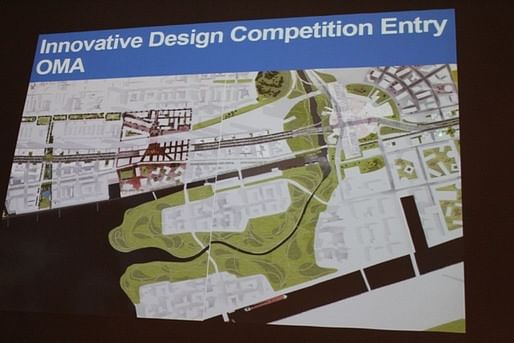
[OMA's "wild" proposal of a mega mixed-mode transportation hub on a naturalized area--something like this is actually now being attempted by a developer, so maybe OMA's idea wasn't as wild as everyone thought at first.]
7:01 pm: Our approach as planners is not to list our constraints and then list all the things we can't do, then make a smaller list of things that we can do. If I sound cynical, it's because I used to be a planner and I think planners do that al the time--make design decisions that they don't realize are design decisions. Engineers are even worse at that.
The West Don Lands was turned over to Waterfront Toronto to do the hard work of the negotiations and public consultations. Glaisek had to convince his supervisor that a landscape architect needed to be hired--"Why do we need that? We already have a precinct plan." I think landscape architects often don't manage the civil engineers because they don't know how to do it--"If Harvard wants to make a contribution to the profession, teaching how to manage civil engineers could be it."
People didn't realize that the landscape design was something to fight for or work around, and would say "I don't want a tree right outside my door like that," to which Glaisek would respond, "Well then put your door somewhere else. The streetscape and trees are designed and that's where they'll be." Glaisek says "You should have seen the look on their faces, but now everyone in Toronto expects that from me."
The historical landscape tradition of parks in Toronto was to cover over quarries and let trees grow there. "There was no Olmsted in Toronto."
When the province decided to bid for the 2015 Pan Am Games, they chose this site because it was already planned and approved. It's very had to get an athlete's village through the approval process in the seven years that you have after a bid. But the province also wanted more density, and the community, which had been working with Waterfront Toronto, pushed back. The plan will be built very close to the original plan.
The Precinct Plan was designed by Fred Koetter and Susie Kim, who are here tonight. "We worked hard with the community on this project; the community worked iteratively on the project with Koetter | Kim & Associates. A bit political because another proposal had been championed by a friend of the then-mayor.
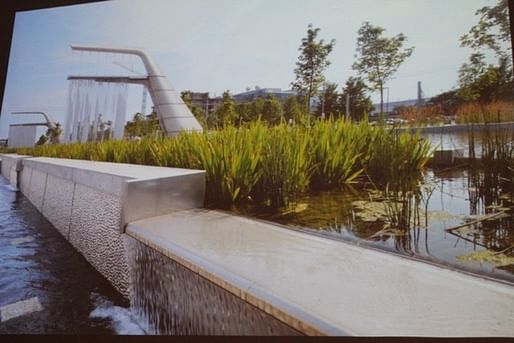
Public art sculptures that are filtering the water and passing it through marsh to help clean the water. We had a lot of lengthy debates...because [late in the game, once the design was done] the water department said we couldn't get the water clean enough. And we said, well, how clean do you want it to be? And they couldn't say because they didn't have a standard. So we helped them develop a standard that we could use. A lot of things can't get done unless you're willing to do the other guy's job.
A lot of developers that aren't used to working with top-end architects are now coming forward with proposals with significant architects on board. "Whether or not you like the designs of these buildings, these are developers who would not have been used to working with architects of this caliber before, and now they know they have to if they want a chance of getting selected."
 Precinct planning was one of our tools. Another is design competitions. We engaged the community in writing the competition brief. There was also a competition for Queens Quay Boulevard, which had been identified by an architect as the second ugliest street in Canada. (Ha--I used to live in that very building on Queens Quay and indeed, it was a very ugly place.) Halfway through the competition, the teams had to come back to Toronto to have a crit with the community as well as with the city's technical staff--that meeting was probably more painful for the teams. The results of the competition were shared at BCE Place, an arcade by Calatrava downtown, and 500 members of the public came out for the event.
Precinct planning was one of our tools. Another is design competitions. We engaged the community in writing the competition brief. There was also a competition for Queens Quay Boulevard, which had been identified by an architect as the second ugliest street in Canada. (Ha--I used to live in that very building on Queens Quay and indeed, it was a very ugly place.) Halfway through the competition, the teams had to come back to Toronto to have a crit with the community as well as with the city's technical staff--that meeting was probably more painful for the teams. The results of the competition were shared at BCE Place, an arcade by Calatrava downtown, and 500 members of the public came out for the event.
"I think we've managed to retain the strengths of the design while making the modifications that were necessary to get the project approved by everyone in the city that approves anything related to streets." There were lots of meetings--for example, there is no other street crossing like this in Toronto, with the road, then the tracks for the streetcar, then---and the surfaces had to be worked out in detail for blind accessibility. 
"The idea captivated people so much that we were able to get another $80 million for the project, beyond the $20 million for the wavedecks. That was based on the quality of the idea and the work that was done in working with the community to build a constituency. It has to be an idea about design that does this--I've never seen a planning diagram that got me really excited, and that's not what you can bring to the public. The designers were seen as problem solvers, not just as aestheticians, and the images they created helped motivate people to find solutions to the problems. 
Most of this sidewalk is privately owned, so it was hard to convince the board to allocate money for the granite to improve this space. But it was a public improvement, as an accessible easement. All sixteen condo buildings were convinced to participate in a cost-sharing program by this rendering, that showed how the project would integrate the buildings into the public space.
Eight years after the design competition, we're finally building it, in the coldest winter in Toronto's history.
The second competition was for the Lower Don Lands and Don River. It was difficult to convince everyone to hold a design competition, because they thought that the hydrological problems couldn't be solved in that context. So we insisted that the teams each have the right technical expertise. The winning scheme was by Michael Van Valkenburgh, who proposed moving the river mouth and naturalizing it on either side. The public who wanted naturalization strongly supported this project. 
The mayor wanted to hand the land over to his buddy to build a ferris wheel and a shopping mall--this is the same mayor who smokes crack so I don't know where that idea came from. But we did have to spend a year re-evaluating this project in light of the ferris wheel and shopping mall idea, but because this idea really was very sound, it was not a problem. Had to make concessions to the Port Authority, the city, and private landowners, but they worked with MVVA and make it work. 
[Kuwabara and Waldheim look on. They approve of EVERYTHING!]
7:51 pm: Bruce Kuwabara. Very exciting to work on these projects. High-speed urbanism. "It was humbling..." to see the landscape architects' designs, in terms of thinking at such a large scale.
"Our city is growing so fast."
"I encourage you all to move up, step out of whatever you are doing and step into a different role, maybe engage the design process at the urban scale."

"Design review...has been a learning process for all of us. Design Review is only an advisory group--we don't say yes or no but just provide advice." BK talks about how amazing it is to see and be involved in so many presentations, and the best presentations he's ever seen. Not just the schematic design, but all the material and construction details, the construction drawings, everything.
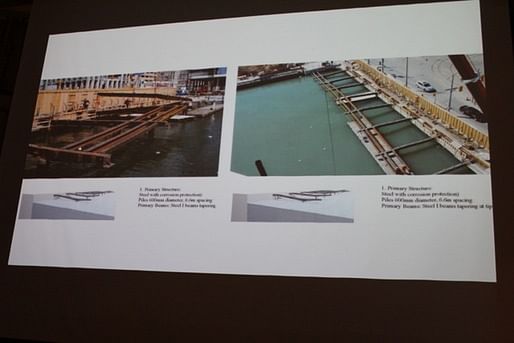

This was Safdie's first proposal (above left), and I was dreading the meeting because what was I going to say? But he came back with this proposal (on the right)--and can you imagine how much value this space (the treed area to the left of the building) gives back to this building?

Brigitte Shim thought this canopy, on Safdie's building (above), should come out longer (as below). It's a difficult thing, because Safdie is a highly respected, well known architect, so it's tricky telling any architect what they should do with their building. It requires a level of respect and collegiality.
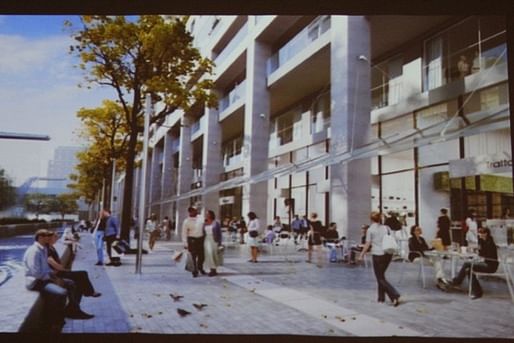 Claude Cormier from Montreal brings a different sensibility--he's seen these work in Europe and nobody in Toronto would have ever proposed this. People didn't think it would work, but these are hugely popular. You can hardly get a seat on the beach.
Claude Cormier from Montreal brings a different sensibility--he's seen these work in Europe and nobody in Toronto would have ever proposed this. People didn't think it would work, but these are hugely popular. You can hardly get a seat on the beach.
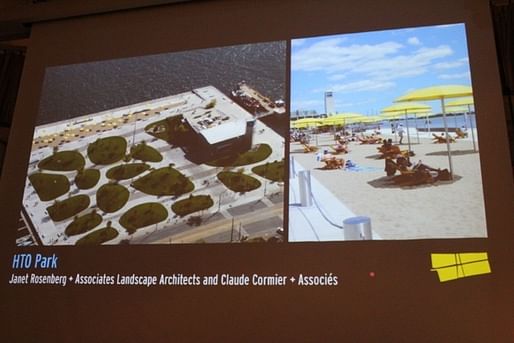
Gilles Saucier's project...is very difficult, but it may be the best work of architecture on the waterfront. He's managed to create an eastern-facing gateway to the downtown...His problem was to make it continuous even though the freeway would pass through.

Younger designers were brought in, for example for this polished stainless steel ceiling which reflects light and which changes the way that people experience and think about moving under the freeway.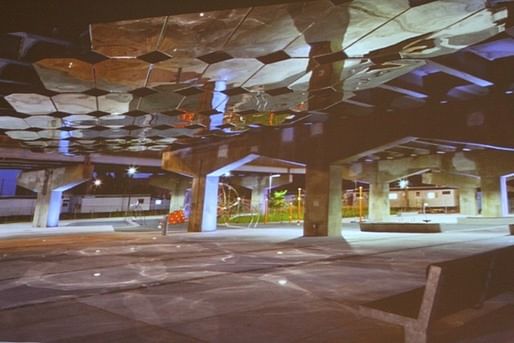
[This is crazy--BK is going through designs for the entire waterfront--a whole city--all of the designs for which he sits on the review panel. Overwhelming amount of architecture and landscape architecture.] "This has been a very advantageous thing to be able to build a while precinct almost in one go."
"Toronto could really show the way"...but we have a mayor that is really a problem. It's not just funny business on Jon Stewart. 
If you give this kind of urban-scale project to architects, they just give you "salad, salad, salad." (I think the idea is, limp green squiggles to indicate landscape in between the buildings.) But here you have the meat.
Waldheim closes the long evening with the observation that it's amazing to see such a process of community and public engagement work, even though it's so complicated. He notes that it's not something that he sees in the USA, and not in his travels in east Asia, either.
Thanks for reading!
Lian

[Go Canada!]
This blog was most active from 2009-2013. Writing about my experiences and life at Harvard GSD started out as a way for me to process my experiences as an M.Arch.I student, and evolved into a record of the intellectual and cultural life of the Cambridge architecture (and to a lesser extent, design/technology) community, through live-blogs. These days, I work as a data storyteller (and blogger at Littldata.com) in San Francisco, and still post here once in a while.



1 Comment
Go Canada/Toronto!
Block this user
Are you sure you want to block this user and hide all related comments throughout the site?
Archinect
This is your first comment on Archinect. Your comment will be visible once approved.